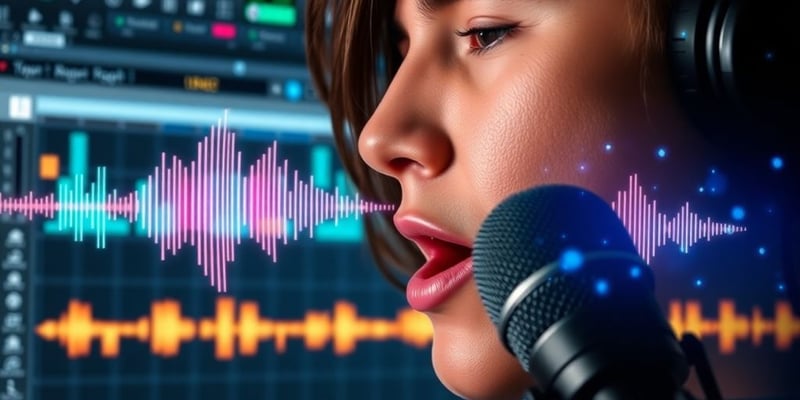
How to Clone My Voice: A Step-by-Step Guide to AI Voice Cloning
Save 15%

Ever wondered how to clone your voice using AI? It's not as sci-fi as it sounds. With the right tools and a bit of patience, you can create a digital replica of your voice. This guide will walk you through the steps to clone your voice, from understanding the basics to exploring advanced features. Whether you're looking to enhance your projects or just curious about the tech, this is your starting point.
Key Takeaways
- AI voice cloning lets you create a digital version of your voice.
- You'll need quality voice samples to get started.
- Choose a reliable voice cloning tool for the best results.
- Understand the ethical implications of using cloned voices.
- Explore advanced features like real-time synthesis and multilingual support.
Understanding AI Voice Cloning
What is AI Voice Cloning?
AI voice cloning is a fascinating technology that uses artificial intelligence to replicate a person's voice. Imagine being able to create a digital version of your voice that sounds just like you, capturing every nuance, from tone to pitch and even your accent. This technology has become a game-changer in various fields, from media to customer service. Whether you're looking to create personalized content or automate responses, AI voice cloning offers a unique way to maintain your voice's authenticity across different platforms.
How Does AI Voice Cloning Work?
At its core, voice cloning involves teaching an AI system to understand and mimic the unique characteristics of your voice. This process starts with collecting high-quality audio samples of your speech. The AI then analyzes these samples to capture your vocal traits, such as tempo and speaking style. Once the system has enough data, it can generate new audio that mimics your original speech patterns. It's like giving your voice a digital twin that can speak on your behalf.
The Evolution of Voice Cloning Technology
Voice cloning technology has come a long way. In the early days, creating a voice clone required extensive manual input and was quite limited in what it could achieve. However, thanks to advancements in AI and machine learning, voice cloning is now more accurate and accessible than ever. Today's tools can create highly convincing voice replicas, making them suitable for real-time applications and automation. As the technology continues to evolve, it raises important ethical questions about privacy and misuse, which are crucial to consider as we move forward.
Preparing to Clone My Voice

Choosing the Right AI Voice Cloning Tool
Picking the right tool is the first step in your voice cloning journey. There are tons of options out there, each with its own set of features. Some are better for beginners, while others might offer advanced settings for those who want more control. Think about what you need: Are you looking for something simple, or do you need a tool that offers more flexibility? Check out user reviews and maybe try a few demos to see which one feels right.
Setting Up Your Recording Environment
A good recording environment is key to getting a quality voice clone. You don't need a fancy studio, but you do need a quiet space where you can record without interruptions. Make sure your microphone is set up correctly and test it before you start. It might help to use some soft furnishings or blankets to dampen any echo.
- Find a quiet room away from street noise or household sounds.
- Use a decent microphone—your phone's mic might work, but a dedicated one is better.
- Test your setup with a short recording and listen back for any issues.
Gathering Quality Voice Samples
Once your setup is ready, it's time to gather your voice samples. You'll need a range of recordings to give the AI a good idea of how you sound. This means capturing different tones and emotions in your voice. You could read a script or just talk about your day—anything that helps the AI learn your voice's unique characteristics.
- Record yourself speaking naturally and with varied emotions.
- Aim for at least 1-3 minutes of recording time.
- Make sure to save your recordings in a common audio format like MP3 or WAV.
The quality of your voice clone largely depends on the samples you provide. The more variety and clarity in your samples, the better the outcome.
By setting up a good recording environment and choosing the right tool, you're setting yourself up for a successful voice cloning experience. Remember, the more effort you put into preparing, the better your cloned voice will sound. Explore more about voice cloning.
Step-by-Step Guide to Cloning My Voice
Creating a New Project in Voice Cloning Software
Getting started with voice cloning means picking the right software. It's like choosing the right tool for any job; it makes all the difference. Whether you're using a platform like Kapwing or one of the best voice cloning services, start by opening a new project. Most software will have a clear "Create New" button on the dashboard. Once you click it, look for options related to voice or audio. You'll typically find a "Text to Speech" or "Voice Cloning" tab to get started.
Uploading or Recording Voice Samples
Now comes the fun part—getting your voice into the system. You have two main options: upload existing audio files or record new ones. If you have recordings lying around, like podcasts or voice notes, use those. Make sure they're clear and have minimal background noise. If you opt to record, find a quiet place and use a good microphone. You can read a script or just speak naturally, but aim for about 1-3 minutes of varied speech.
Processing and Generating the Voice Clone
Once your samples are ready, it's time to let the software work its magic. Submit your recordings for processing. This step usually takes a few minutes, depending on the software and the length of your samples. After processing, you'll get a preview of your cloned voice. Listen carefully. If it sounds off, you might need to tweak your samples or record new ones. Once you're satisfied, your cloned voice is ready to use in various applications.
Applications of Cloned Voices
Using Cloned Voices in Media and Entertainment
Cloned voices are transforming the media and entertainment industry. Imagine a world where your favorite actors can perform in multiple projects simultaneously without ever stepping foot on set. Voice cloning technology makes this possible by allowing actors to lend their voices to characters across films, animations, and video games, creating a seamless experience for the audience. This technology also enables the dubbing of films into various languages without losing the original performance's essence, broadening the reach of content globally.
Enhancing Customer Support with AI Voices
In customer support, cloned voices offer a unique advantage. By deploying voice clones, companies can maintain a consistent brand voice across all customer interactions. This consistency not only builds trust but also enhances user experience by providing a familiar voice that customers recognize. Additionally, AI voices can handle customer inquiries 24/7, reducing wait times and improving service efficiency. This advancement in AI voice technology ensures that interactions are more natural and engaging, which is crucial in maintaining customer satisfaction.
Personalizing Marketing Campaigns
Marketing has always been about creating a connection with the audience, and voice cloning takes this to a new level. Brands can now use cloned voices to personalize advertisements, making them more relatable and impactful. By using a familiar voice, companies can evoke emotions and create a memorable brand experience. This personalized approach not only captures attention but also increases the likelihood of conversion, making marketing campaigns more effective.
The potential of voice cloning is vast, offering innovative solutions across various industries. As the technology evolves, we can expect even more creative applications that will redefine how we interact with digital content.
Ethical Considerations in Voice Cloning
Privacy Concerns and Data Security
Voice cloning technology raises significant privacy concerns. When you clone a voice, you're essentially creating a digital replica of someone's personal data. This means that without proper consent, using someone's voice for cloning can lead to serious privacy violations. It's crucial to ensure that any voice data collected is stored securely and used only for the intended purposes. Data breaches and unauthorized access to voice data can have severe consequences, including identity theft and fraud. Therefore, robust security measures must be in place to protect this sensitive information.
Avoiding Misuse of Cloned Voices
The potential for misuse of cloned voices is a major ethical issue. With the ability to make a voice sound like someone else, there's a risk of creating misleading or harmful content. For instance, cloned voices could be used to produce fake audio recordings that could damage reputations or spread misinformation. To prevent such misuse, it's important to have clear guidelines and restrictions on how cloned voices can be used. This means not only obtaining explicit consent from the voice owner but also ensuring that the ethical landscape of voice replication technology is adhered to, emphasizing the necessity of clear consent and ownership.
Legal Implications of Voice Cloning
Legal challenges are another aspect of voice cloning that cannot be ignored. Different jurisdictions have varying laws regarding the use of personal data, including voice. In some places, using someone's voice without permission could lead to legal action. It's important for individuals and companies involved in voice cloning to be aware of these laws and ensure compliance. This includes understanding the legal ramifications of voice cloning and ensuring that all necessary permissions are obtained before proceeding with any voice cloning activities. Ignoring these legalities can result in hefty fines and damage to one's reputation.
As voice cloning technology continues to evolve, staying informed about ethical and legal considerations is not just advisable but essential. The responsibility lies with both developers and users to ensure that this powerful technology is used wisely and ethically.
Maximizing the Quality of My Voice Clone
Best Practices for High-Quality Voice Clones
Creating a voice clone that sounds just like you isn't just about hitting record and hoping for the best. It's all in the details. Here are some tips to make sure your voice clone is top-notch:
- Mind Your Surroundings: Make sure your recording environment is quiet. Background noise can mess up the quality of your voice clone.
- Be Yourself: Stick to your natural way of speaking. Don’t try to sound different or exaggerated.
- Check Before Submitting: Always listen to your recording before submitting. Make sure it sounds like the real you.
Troubleshooting Common Issues
Sometimes, things don't go as planned. Here are some common hiccups and how to fix them:
- Voice Sounds Robotic: This might be due to poor audio quality. Try re-recording in a quieter space.
- Inconsistent Pitch or Tone: Ensure your voice samples are consistent. Drastic changes in tone or pitch can confuse the AI.
- Audio Distortions: Make sure your microphone is working correctly and isn’t too close to your mouth.
Continuous Improvement and Updates
Voice cloning isn't a one-and-done deal. To keep your voice clone sounding fresh and accurate, it's important to:
- Regularly Update Samples: As your voice changes over time, update your samples to reflect those changes.
- Experiment with Features: Many AI voice tools offer extensive customization options like speed, pitch, and emotional tone. Play around with these to find what works best.
- Stay Informed: Keep an eye on new updates in your voice cloning software. New features might enhance your voice clone even further.
A perfect voice clone doesn't happen overnight. It's a process of trial and error, but with patience, you can create a clone that truly represents your voice.
Exploring Advanced Features of Voice Cloning Tools

Real-Time Voice Synthesis
Voice cloning tools have come a long way, and one of the most exciting features is real-time voice synthesis. Imagine speaking into a microphone and hearing your words transformed instantly into a cloned version of your voice. This is not just a cool trick; it opens doors for live performances and interactive applications. Real-time synthesis is a game-changer for live broadcasting and virtual reality experiences. It allows for seamless integration of voice clones into live events, making it feel as though the cloned voice is naturally part of the environment.
Multilingual Voice Cloning
In our interconnected world, being able to communicate in multiple languages is invaluable. Voice cloning technology now supports multilingual capabilities, allowing users to clone their voice in different languages. This means you can create content that appeals to a global audience without losing your unique vocal identity. Whether it's for business presentations, educational content, or entertainment, multilingual voice cloning breaks down language barriers and expands your reach.
Integration with Other AI Technologies
The integration of voice cloning with other AI technologies is where things get really interesting. By combining voice cloning with AI-driven analytics and natural language processing, you can create highly personalized and interactive experiences. For instance, a virtual assistant with your cloned voice can answer questions, provide recommendations, and even engage in complex conversations. This integration not only enhances the functionality of AI systems but also makes them more relatable and user-friendly.
As technology evolves, the possibilities with voice cloning are expanding rapidly. From real-time synthesis to multilingual capabilities, these tools are reshaping how we interact with digital media. It's an exciting time to explore what voice cloning can do for you.
Wrapping It Up
So, there you have it—a straightforward guide to cloning your voice with AI. It's pretty wild how far technology has come, right? With just a few clicks and some audio samples, you can have a digital version of your voice ready to go. Whether you're using it for fun, work, or something else entirely, the possibilities are endless. Just remember to use this tech responsibly. It's a powerful tool, and with great power comes—you know the rest. Anyway, happy voice cloning!
Frequently Asked Questions
What is AI voice cloning?
AI voice cloning is a technology that uses artificial intelligence to create a digital copy of someone's voice. It analyzes the way a person talks, including their tone and pitch, to make a voice that sounds just like them.
How does AI voice cloning work?
AI voice cloning works by taking recordings of a person's voice and using them to teach a computer how to mimic that voice. The computer learns the unique sounds and patterns of the voice to create new speech that sounds like the original person.
What do I need to clone my voice?
To clone your voice, you'll need a good microphone to record clear samples of your voice. You'll also need software or an app that can process these recordings and create a digital version of your voice.
Is it possible to use cloned voices in different languages?
Yes, some advanced voice cloning tools can create voices in multiple languages. This means you can have your voice sound like it's speaking a different language, even if you don't speak it fluently.
Are there any ethical issues with voice cloning?
Yes, there are ethical concerns with voice cloning, like privacy issues and the potential for misuse. It's important to use this technology responsibly and be aware of the legal implications.
What can I use a cloned voice for?
Cloned voices can be used in many ways, like for making audiobooks, videos, or even for personalizing customer service. They can help make content creation faster and more consistent.









